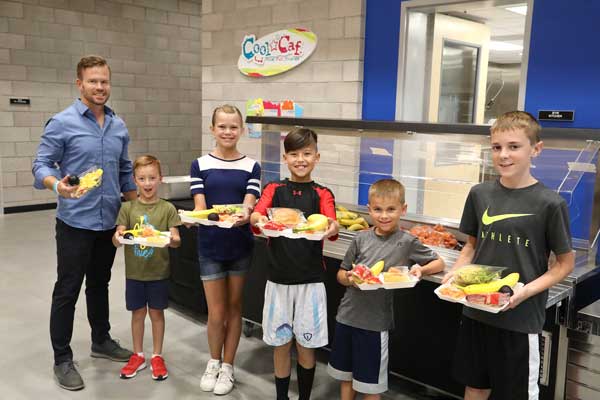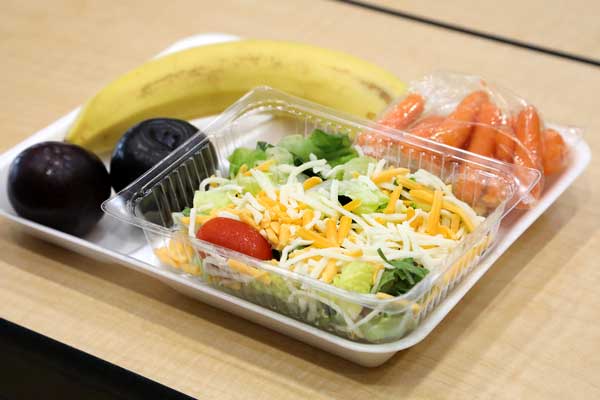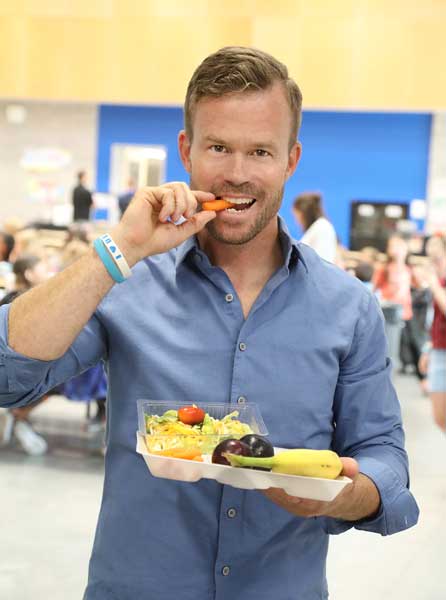FUELING STUDENTS’ SUCCESS
A conversation about the National School Lunch Program in Reno-Tahoe.
Written by Claire McArthur
Photos by Lou Manna
One in six children in the United States grows up in a family that struggles with hunger and food insecurity. It’s a significant issue that not only affects children’s home life, but also their performance in school. Three out of four educators see students regularly come to school hungry, according to a 2017 study by the anti-hunger organization Share Our Strength. Ninety-two percent of teachers are concerned with how hunger affects their students’ success, while 76 percent see poor academic performance stemming from hunger.
Though food insecurity still remains an issue for many students, the National School Lunch Program has made strides in addressing the issue across the country, including in Nevada. Edible Reno-Tahoe caught up with Joe Dibble, school nutrition supervisor for the Nevada Department of Agriculture, to talk about what goes into running the largest “restaurant” for students of all income levels across the state.
ERT: What is the National School Lunch Program, and what role does the Nevada Department of Agriculture play in administering it?
JD: The National School Lunch Program, established in 1946, is a federally assisted meal program operating in public schools, nonprofit private schools, and residential child-care institutions, or RCCIs. NSLP provides children with nutritionally balanced, low-cost or free lunches during the school day.
Nevada Department of Agriculture administers NSLP, and other federal school nutrition programs, statewide through annual agreements with school districts, charter schools, and RCCIs. Approved sites receive cash subsidies and commodities for each qualifying meal they serve. In exchange, these institutions must serve meals that meet the federal nutrition standards and provide them at a free or reduced price to eligible children.
The NDA provides training and technical support to school district food-service staff. Our role is to help school districts maintain compliance with federal requirements.
ERT: How many students participate in the NSLP across Nevada?
JD: In Nevada, 16 of 17 school districts, 15 public charter schools, 10 RCCIs, two tribal schools, and one private charter school currently participate in the NSLP. During the 2018-19 school year, 274,000 K-12 students were eligible for either free or reduced-priced lunches, and 37,959,628 lunches were served statewide. In Northern Nevada (which includes schools at or north of Highway 50), 7,651,950 lunches were served.

From left, Joe Dibble and Reno’s Nick Poulakidas Elementary School students Jackson Conover, Aubree Wright, Brady Forrest, Bodie Botelho, and Thomas Sutton select healthy school lunch options
ERT: Many of these students also receive free or reduced-priced meals. What qualifies them for that?
JD: Students qualify for free or reduced-priced meals automatically if already enrolled in another federal assistance program (such as the Supplemental Nutrition Assistance Program, Temporary Assistance for Needy Families, Food Distribution Program on Indian Reservations, or Medicaid). Families also can complete a meal application form provided through their schools. The income eligibility guidelines for child nutrition programs are set by the USDA Food and Nutrition Service.
(Children in households with incomes at or below 130 percent of the federal poverty level are eligible for free meals, while those in households with incomes between 130 and 185 percent of the federal poverty level are eligible for reduced-price school meals. The cost for breakfast cannot exceed 30 cents per child per day, and 40 cents for lunch.)
ERT: How big an issue is food insecurity for K-12 students in Nevada? What does the state do to address it?
JD: Nearly 60 percent of students in Nevada qualify for free or reduced-price meal programs, so there is a great need in our state. We offer as much assistance to school districts as we can in promoting the availability of nutritious meals through NSLP, and our staff is in regular communication with district food-service directors to provide support.
We also have increased breakfast availability through Breakfast After the Bell (SB-503), which began in 2015 and required Nevada schools with 70 percent or greater free or reduced-price lunch eligibility to offer meals after the start of the school day. The bill also included $2 million in general funds to help schools implement these programs to ensure all children start their day with a nutritious meal that makes them ready to learn.
There are additional federal programs available to Nevada that bring fresh fruits and vegetables into schools, such as the Fresh Fruit and Vegetable Program and DoD Fresh. NDA also administers federal summer meal programs to fill the gap when school is not in session.
ERT: How does food insecurity/hunger affect students’ performance in school?
JD: It is well known that hungry kids don’t learn as well. School meals can improve test scores, classroom behavior, and the future success of Nevada’s students.
ERT: What are some of the challenges of running statewide programs for school lunches?
JD: The size and capabilities of our NSLP institutions varies greatly, from Clark County School District, with about 350 school sites and 327,000 students, to Duckwater tribal school, with one site and only 16 students. Staffing, time, and resources always are stretched thin across our very large state.
Some of the universal challenges we see across all school districts include providing delicious, affordable meals that meet the nutrition standards. We have seen many school districts introduce new and exciting meal offerings and taste tests to increase participation and reduce waste.

A healthy lunch served at Nick Poulakidas Elementary School for the National School School Lunch Program
ERT: How has the program evolved to address nutritional needs?
JD: The passing of the Healthy, Hunger-Free Kids Act of 2010 represented some major improvements in NSLP menus, including adding whole-grain-rich products and low-fat milk and offering more colorful fruits and vegetables daily. NSLP meals now have sodium, calorie, saturated fat, and trans-fat restrictions.
The HHFKA also brought about changes to local school wellness policies, enforcing nutritional regulations and limitations for food and beverages sold and given away on school campuses outside of the lunch service. Nevada’s school districts have worked hard to address nutritional requirements and ensure students have access to more healthful foods.
ERT: Is unpaid school lunch debt an issue in Nevada?
JD: Unpaid school lunch debt is an issue across the country, and Nevada is no exception. In 2016, all participating districts and charter schools were required by USDA to develop policies and procedures to handle cases in which a child is served a meal and does not have money to pay for that meal. Every school district in Nevada has a plan to work with families and address school lunch debt.
Our program staff is here to help schools and school districts maintain compliance with federal nutrition guidelines, promote the nutritional value of school meals, and ensure access to any child who wants and needs a meal.
__________________
Claire McArthur is a freelance writer who has great respect for the work that’s being done across the state by people like Joe Dibble to help Nevada’s students live better, healthier lives.


